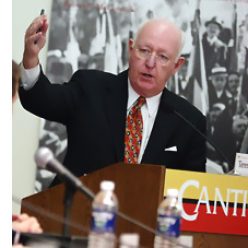It was a tantalizing find, a possible solution to a four-century-old mystery, and it sent a shiver of excitement through the small band of obsessive amateur historians that continue to search for artifacts from Captain John Smith’s legendary voyages of exploration of the Chesapeake Bay in 1608.
The discovery, in June, 2010, by Maryland archeologist Darrin Lowery, on Mockhorn Island, a marshy expanse on the Atlantic side of Virginia’s Eastern Shore, was a small, metal Maltese cross.
Dr. Lowery, who has turned up more than 700 ancient artifacts in his extensive field work, was immediately intrigued when a colleague literally stepped on the cross at low tide. The object caught his eye because it resembled the Maltese design of the 27 crosses that Captain Smith depicted on his famous map of the Bay to mark the highpoints of his explorations.
Smith wrote in his journal and histories that he carved crosses into trees and nailed up brass versions of the cross “to signify to any that Englishmen had been there.” In effect, he was stamping it “Property of England.”
Historians and enthusiasts have been searching for the famous crosses for 400-plus years. Now, on a hot, sticky June day, with insects biting at his ankles, Lowery was looking excitedly at a metal Maltese cross on a site that his research had proved was Smith’s first landfall at the outset of his 1608 exploration voyage.
“Of course I was intrigued,” he said, with admirable understatement. This, potentially, was the Holy Grail of Chesapeake colonial research. He sent it to be analyzed and dated by experts at the Smithsonian Institutions and later at the Virginia Department of Historic Resources in Richmond, a process that proceeded at an academic pace, meaning years.
Captain John Smith’s explorations of the Chesapeake Bay four centuries ago have captured the imagination of generations of enthusiasts who have read his journals and writings and poured over his extraordinarily accurate map of the Bay. I confess I am one of them. My curiosity was piqued in 2007, when I re-traced Captain Smith’s routes around the Bay for a cover story for The Smithsonian magazine.
It was a grand journey, from Jamestown to Havre de Grace, with lots of side excursions. Four centuries earlier, Cap’n Jack, as I came to think of him fondly, even though we are not related, had sailed and rowed the broad waters and nooks and crannies of the Bay with a dozen men in an open boat known as a shallop, braving storms and hostile natives. As a modern-day softie, I covered most of it in a friend’s lovely yacht.
Following his extraordinarily accurate map and guided by his keenly-observed journal, I came to admire Cap’n Jack for his courage, determination and resourcefulness, even though some of the settlers at Jamestown apparently considered him to be an arrogant little braggart.
And, like so many others, I wondered: what became of the famous crosses? I consulted Edward Wright Haile, poet, surveyor and author of the elegant “John Smith in the Chesapeake,” who, with historian and author Connie Lapallo, spearheads the John Smith Cross Project of the Chesapeake Conservancy, a partner organization with the National Park Service in developing the Captain John Smith Chesapeake National Historic Trail, better known as the Water Trail. Working together, they have established 15 stone markers where Cap’n Jack put his crosses, and have more to go.
So, where are the crosses today? “Obviously, I don’t know,” Haile said. “They may exist in someone’s attic, or, very possibly, the Indians took the brass crosses and melted them down or converted them to their own uses. We still hope to find out.”
Meanwhile, what of the Mockhorn Island cross? Is it an authentic John Smith cross?
“No, definitely not,” said Darrin Lowery, who told me he had had finally heard from the experts in Richmond, who had subjected his find to all manner of tests.
“They told me it is old, but not that old,” he said. “They think it may be part of a horse’s bridle that fell off and got buried. Or something else. But it’s not John Smith’s.”
So, 410 years after Cap’n Jack set out to explore the Bay and nailed his crosses, the great Chesapeake mystery continues.
